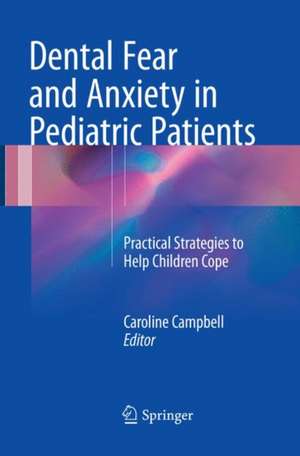Dental Fear and Anxiety in Pediatric Patients: Practical Strategies to Help Children Cope
Editat de Caroline Campbellen Limba Engleză Paperback – 20 iul 2018
; these provide practitioners with options to help resolve DFA and phobia regarding needles. Intravenous sedation, including the challenge of cannulation, is covered comprehensively. Furthermore, cognitive behavioral therapy is presented, with suggestion of practical self-help material when appropriate. The closing chapter looks to the future, discussing the barriers to and the changes required for the creation of more child-centered DFA services.
| Toate formatele și edițiile | Preț | Express |
|---|---|---|
| Paperback (1) | 713.39 lei 38-44 zile | |
| Springer International Publishing – 20 iul 2018 | 713.39 lei 38-44 zile | |
| Hardback (1) | 985.22 lei 38-44 zile | |
| Springer International Publishing – 7 mar 2017 | 985.22 lei 38-44 zile |
Preț: 713.39 lei
Preț vechi: 750.94 lei
-5% Nou
Puncte Express: 1070
Preț estimativ în valută:
136.50€ • 142.91$ • 112.95£
136.50€ • 142.91$ • 112.95£
Carte tipărită la comandă
Livrare economică 01-07 aprilie
Preluare comenzi: 021 569.72.76
Specificații
ISBN-13: 9783319840048
ISBN-10: 3319840045
Pagini: 252
Ilustrații: XIII, 252 p. 105 illus., 73 illus. in color.
Dimensiuni: 155 x 235 x 16 mm
Greutate: 0.45 kg
Ediția:Softcover reprint of the original 1st ed. 2017
Editura: Springer International Publishing
Colecția Springer
Locul publicării:Cham, Switzerland
ISBN-10: 3319840045
Pagini: 252
Ilustrații: XIII, 252 p. 105 illus., 73 illus. in color.
Dimensiuni: 155 x 235 x 16 mm
Greutate: 0.45 kg
Ediția:Softcover reprint of the original 1st ed. 2017
Editura: Springer International Publishing
Colecția Springer
Locul publicării:Cham, Switzerland
Cuprins
Part I: Background & Assessment.- Background and Prevalence of Dental Fear and Anxiety.- Patient and Parental Preparation.- Dental Fear and Anxiety Assessment in Children.- Coping Styles in Children.- The Assessment Visit.- Treatment Allocation- Explaining the Options.- Part II: Treatment.- Non Pharmacological Behaviour Management Techniques: An Art and a Science.- Communication and the use of Language.- Relaxation.- Hypnosis.- I.V. Sedation.- Techniques to help Children Cope with Local Anaesthesia.- Cognitive Behavioural Therapy.- Part III: Moving Forward.- A child Centred Service: The Voice of the Child.
Recenzii
“This is a guide to the management of pediatric dental fear and anxiety (DFA) and phobia to help practitioners fully comprehend all the factors associated with managing the condition. … The target audience is dental practitioners. Other audiences include students, residents, and allied dental providers. … This is a good quality, comprehensive overview of dental anxiety and phobia in children. The book is also useful in assisting practitioners in effectively managing patients in the dental office presenting with these challenges.” (Janet H. Southerland, Doody’s Book Reviews, June, 2017)
Notă biografică
Caroline M. Campbell, BDS, MSc, MFDS RCPSG, M Paed Dent (Ed), FDS Paed Dent (Glas), is a Consultant in Paediatric Dentistry with a Role in Undergraduate Training at the Greater Glasgow and Clyde NHS Trust and Honorary Senior Clinical Lecturer at the University of Glasgow, UK. She is an External Adviser in Paediatric Dentistry to the Academy of Medical Royal Colleges and Faculties in Scotland, Representative for Royal College Physicians and Surgeons Glasgow on specialist training committee for Paediatric Dentistry and chairperson of the British Society of Paediatric Dentistry – West of Scotland Branch. Within her department, she has been responsible for a variety of initiatives. These include instigation of use of the child dental anxiety assessment tool Faces Modified Child Dental Anxiety Scale (f MCDAS), improvement of the referral pathway and patient management, introduction of a needle desensitization and relaxation technique, and establishment of a database for children attending sedation that has enabled her to evidence anxiety reduction for inhalation sedation, hypnosis, and relaxation techniques. She continues to undertake research, having received two research prizes and given talks on her activities at international, national, and local levels during the past 3 years. She is the author of a number of papers in peer-reviewed journals. In addition, she has extensive under- and postgraduate teaching experience.
Textul de pe ultima copertă
This book is a comprehensive guide to pediatric dental fear/anxiety (DFA) and phobia that will provide practitioners with a full understanding of the etiology, prevalence, assessment, and management of these conditions. The coping styles of children when under stress are explored, with discussion of their relevance to the assessment visit and treatment allocation. Practical treatment techniques are comprehensively covered, from non-pharmacological behavioral strategies relevant for children with no or mild DFA to those approaches more appropriate for children with severe DFA/phobia. The importance of the use of language and communication skills to build rapport and allay anxiety is explored. Relaxation and hypnosis techniques are described, with guidance on how to introduce these to patients and their parents/carers. Techniques that help children cope when receiving injections are detailed, including systematic needle desensitization
; these provide practitioners with options to help resolve DFA and phobia regarding needles. Intravenous sedation, including the challenge of cannulation, is covered comprehensively. Furthermore, cognitive behavioral therapy is presented, with suggestion of practical self-help material when appropriate. The closing chapter looks to the future, discussing the barriers to and the changes required for the creation of more child-centered DFA services.
; these provide practitioners with options to help resolve DFA and phobia regarding needles. Intravenous sedation, including the challenge of cannulation, is covered comprehensively. Furthermore, cognitive behavioral therapy is presented, with suggestion of practical self-help material when appropriate. The closing chapter looks to the future, discussing the barriers to and the changes required for the creation of more child-centered DFA services.
Caracteristici
Covers a wide range of practical treatment techniques Identifies the indications and limitations of different approaches Assesses the evidence base Explains the relevance of patients’ coping strategies to treatment

















